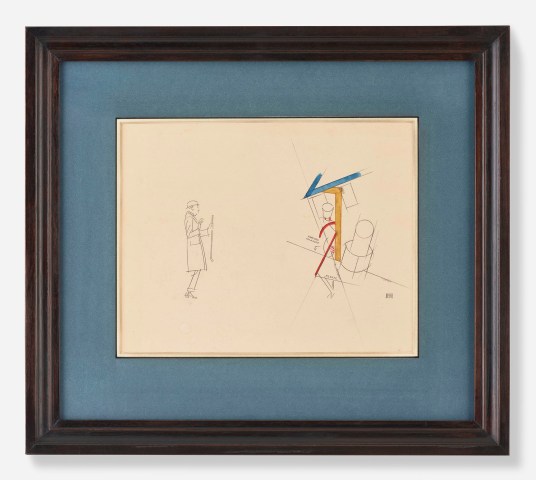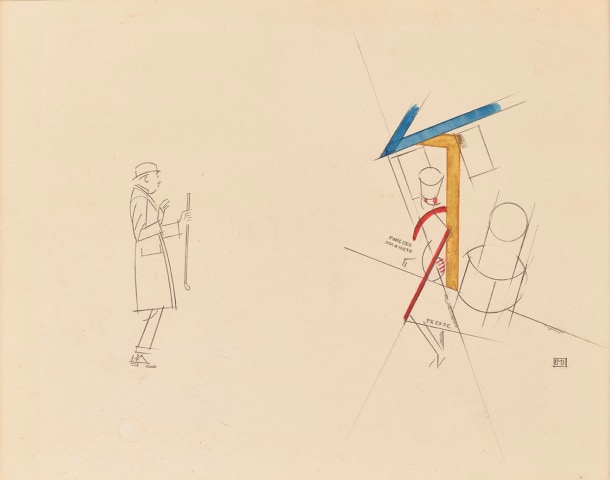Bernard Boutet de Monvel
La Peinture Absolue, c.1920
Pencil, pen and ink and coloured wash on paper, with artist's estate stamp (lower right)
21.5 x 27cm
2P C
$ 12,000
In the short story 'La peinture absolue' by Henry Bidou, published in the Gazette du Bon Ton in March 1920, a fictional character named Luc visits the very real Galerie...
In the short story "La peinture absolue" by Henry Bidou, published in the Gazette du Bon Ton in March 1920, a fictional character named Luc visits the very real Galerie de l'Effort Moderne (1910-1941), located on Rue de La Baume in Paris and adding force in promoting avant-garde Cubist art. Luc visits the exhibition of Jean Metzinger's work, which had been organised by Léonce Rosenberg in January 1919. The accompanying illustrations, produced by the incomparable Bernard Boutet de Monvel, in the Gazette du Bon Ton, depict Luc's experience at the exhibition. They are some of his most iconic drawings, and the represent composition, known in varying degrees of finish, is arguably the most exemplary with this being the most-worked up version.
As Luc studies each canvas closely, he becomes captivated by Metzinger's technique and the rigorous compositions present in his paintings. During his visit, Luc encounters an old man who describes Metzinger's work as "la peinture absolue" or "absolute painting." The man explains to Luc that Metzinger is not merely depicting things but rather capturing the essence and eternal prototype of beings. According to the old man, one must paint the essence of things rather than copying them.
Luc responds by reflecting on his own artistic journey. He confesses that he used to embrace this perspective in his youth but eventually became an Impressionist, which he believes tainted the purity of his soul unlike that of Metzinger. As Luc departs the gallery, his perception of the universe is transformed. He begins to view everything in terms of lines, angles, and geometry, embracing the principles of Cubism.
Jean Metzinger (1883-1956) himself was a prominent French painter and art theorist closely associated with the Cubist movement. His artistic approach evolved from Neo-Impressionism to a more geometric and analytical style. Metzinger's philosophy of "absolute painting" emphasised the autonomy of the artwork, moving away from mere representation and focusing on the intrinsic qualities of painting itself. By reducing subjects to geometric elements, he aimed to create a profound and universal form of expression.
Metzinger's contributions to Cubism, his exploration of "absolute painting," and his innovative use of form, composition, and multiple perspectives significantly impacted the course of modern art. His work, alongside other Cubist artists, paved the way for abstract art movements in the 20th century and continues to inspire generations of artists.
As Luc studies each canvas closely, he becomes captivated by Metzinger's technique and the rigorous compositions present in his paintings. During his visit, Luc encounters an old man who describes Metzinger's work as "la peinture absolue" or "absolute painting." The man explains to Luc that Metzinger is not merely depicting things but rather capturing the essence and eternal prototype of beings. According to the old man, one must paint the essence of things rather than copying them.
Luc responds by reflecting on his own artistic journey. He confesses that he used to embrace this perspective in his youth but eventually became an Impressionist, which he believes tainted the purity of his soul unlike that of Metzinger. As Luc departs the gallery, his perception of the universe is transformed. He begins to view everything in terms of lines, angles, and geometry, embracing the principles of Cubism.
Jean Metzinger (1883-1956) himself was a prominent French painter and art theorist closely associated with the Cubist movement. His artistic approach evolved from Neo-Impressionism to a more geometric and analytical style. Metzinger's philosophy of "absolute painting" emphasised the autonomy of the artwork, moving away from mere representation and focusing on the intrinsic qualities of painting itself. By reducing subjects to geometric elements, he aimed to create a profound and universal form of expression.
Metzinger's contributions to Cubism, his exploration of "absolute painting," and his innovative use of form, composition, and multiple perspectives significantly impacted the course of modern art. His work, alongside other Cubist artists, paved the way for abstract art movements in the 20th century and continues to inspire generations of artists.
Provenance
Among the contents of the artist’s studio in Paris at the time of his death
By descent to the artist’s daughter, Sylvie Boutet de Monvel, Paris
Private Collection, France, until 2023
Literature
Henry Bidou, ‘La peinture absolue’, Gazette du Bon Ton, March 1920, p.41.



